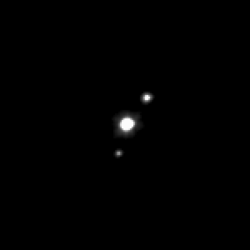 (386723) 2009 YE7 among other Haumea family objects | |
| Discovery [1] | |
|---|---|
| Discovered by | David Rabinowitz |
| Discovery date | 17 December 2009 |
| Designations | |
| 2009 YE7 | |
| K09Y07E | |
| TNO Cubewano [2] Haumea family [3] [4] | |
| Orbital characteristics [5] | |
| Epoch 13 January 2016 (JD 2457400.5) | |
| Uncertainty parameter 4 | |
| Observation arc | 2273 days (6.22 yr) |
| Aphelion | 50.694 AU (7.5837 Tm) |
| Perihelion | 37.893 AU (5.6687 Tm) |
| 44.293 AU (6.6261 Tm) | |
| Eccentricity | 0.14450 |
| 294.79 yr (107672 d) | |
| 180.87° | |
| 0° 0m 12.037s / day (n) | |
| Inclination | 29.080° |
| 141.71° | |
| ≈ 5 May 2164 [6] ±15 days | |
| 99.077° | |
| Physical characteristics | |
| 200 [7] –560 [8] km [5] [9] | |
| assume 0.7 to 0.09 | |
| Temperature | < 44 K |
| (Neutral) | |
| ≈21.7(JPL Horizons) | |
| 4.5 [5] | |
(386723) 2009 YE7 (provisional designation 2009 YE7) is a trans-Neptunian object (TNO) discovered by David Rabinowitz on December 17, 2009, at the La Silla Observatory in Chile.


